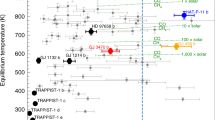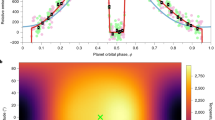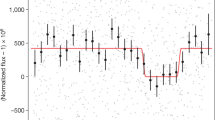Abstract
Most known terrestrial planets orbit small stars with radii less than 60 per cent of that of the Sun1,2. Theoretical models predict that these planets are more vulnerable to atmospheric loss than their counterparts orbiting Sun-like stars3,4,5,6. To determine whether a thick atmosphere has survived on a small planet, one approach is to search for signatures of atmospheric heat redistribution in its thermal phase curve7,8,9,10. Previous phase curve observations of the super-Earth 55 Cancri e (1.9 Earth radii) showed that its peak brightness is offset from the substellar point (latitude and longitude of 0 degrees)—possibly indicative of atmospheric circulation11. Here we report a phase curve measurement for the smaller, cooler exoplanet LHS 3844b, a 1.3-Earth-radii world in an 11-hour orbit around the small nearby star LHS 3844. The observed phase variation is symmetric and has a large amplitude, implying a dayside brightness temperature of 1,040 ± 40 kelvin and a nightside temperature consistent with zero kelvin (at one standard deviation). Thick atmospheres with surface pressures above 10 bar are ruled out by the data (at three standard deviations), and less-massive atmospheres are susceptible to erosion by stellar wind. The data are well fitted by a bare-rock model with a low Bond albedo (lower than 0.2 at two standard deviations). These results support theoretical predictions that hot terrestrial planets orbiting small stars may not retain substantial atmospheres.
This is a preview of subscription content, access via your institution
Access options
Access Nature and 54 other Nature Portfolio journals
Get Nature+, our best-value online-access subscription
$29.99 / 30 days
cancel any time
Subscribe to this journal
Receive 51 print issues and online access
$199.00 per year
only $3.90 per issue
Buy this article
- Purchase on Springer Link
- Instant access to full article PDF
Prices may be subject to local taxes which are calculated during checkout




Similar content being viewed by others
Data availability
The raw data used in this study are available at the Spitzer Heritage Archive, https://sha.ipac.caltech.edu/applications/Spitzer/SHA.
Code availability
We processed and fitted the data with the open-source pipeline POET, which is available at https://github.com/kevin218/POET. We used the code version corresponding to commit ID adbe62e7b733df9541231e8d1e5d32b7e2cdad76.
References
Dressing, C. D. & Charbonneau, D. The occurrence of potentially habitable planets orbiting M dwarfs estimated from the full Kepler dataset and an empirical measurement of the detection sensitivity. Astrophys. J. 807, 45 (2015).
Fulton, B. J. et al. The California–Kepler survey. III. A gap in the radius distribution of small planets. Astron. J. 154, 109 (2017).
Tarter, J. C. et al. A reappraisal of the habitability of planets around M-dwarf stars. Astrobiology 7, 30–65 (2007).
Luger, R. & Barnes, R. Extreme water loss and abiotic O2 buildup on planets throughout the habitable zones of M dwarfs. Astrobiology 15, 119–143 (2015).
Wordsworth, R. Atmospheric heat redistribution and collapse on tidally locked rocky planets. Astrophys. J. 806, 180 (2015).
Shields, A. L., Ballard, S. & Johnson, J. A. The habitability of planets orbiting M-dwarf stars. Phys. Rep. 663, 1–38 (2016).
Seager, S. & Deming, D. On the method to infer an atmosphere on a tidally locked super Earth exoplanet and upper limits to GJ 876d. Astrophys. J. 703, 1884–1889 (2009).
Selsis, F., Wordsworth, R. D. & Forget, F. Thermal phase curves of nontransiting terrestrial exoplanets. I. Characterizing atmospheres. Astron. Astrophys. 532, A1 (2011).
Kreidberg, L. & Loeb, A. Prospects for characterizing the atmosphere of Proxima Centauri b. Astrophys. J. Lett. 832, 12 (2016).
Koll, D. D. B. & Abbot, D. S. Temperature structure and atmospheric circulation of dry tidally locked rocky exoplanets. Astrophys. J. 825, 99 (2016).
Demory, B.-O. et al. A map of the large day–night temperature gradient of a super-Earth exoplanet. Nature 532, 207–209 (2016).
Fazio, G. G. et al. The Infrared Array Camera (IRAC) for the Spitzer Space Telescope. Astrophys. J. Suppl. Ser. 154, 10–17 (2004).
Cubillos, P. et al. WASP-8b: characterization of a cool and eccentric exoplanet with Spitzer. Astrophys. J. 768, 42 (2013).
Kreidberg, L. batman: BAsic Transit Model cAlculatioN in Python. Publ. Astron. Soc. Pac. 127, 1161–1165 (2015).
Louden, T. & Kreidberg, L. SPIDERMAN: an open-source code to model phase curves and secondary eclipses. Mon. Not. R. Astron. Soc. 477, 2613–2627 (2018).
Stevenson, K. B. et al. Transit and eclipse analyses of the exoplanet HD 149026b using BLISS mapping. Astrophys. J. 754, 136 (2012).
Lanotte, A. A. et al. A global analysis of Spitzer and new HARPS data confirms the loneliness and metal-richness of GJ 436 b. Astron. Astrophys. 572, A73 (2014).
Vanderspek, R. et al. TESS discovery of an ultra-short-period planet around the nearby M dwarf LHS 3844. Astrophys. J. Lett. 871, 24 (2019).
Hu, R., Ehlmann, B. L. & Seager, S. Theoretical spectra of terrestrial exoplanet surfaces. Astrophys. J. 752, 7 (2012).
de Pater, I. & Lissauer, J. Planetary Sciences (Cambridge Univ. Press, 2001).
Morley, C. V., Kreidberg, L., Rustamkulov, Z., Robinson, T. & Fortney, J. J. Observing the atmospheres of known temperate Earth-sized planets with JWST. Astrophys. J. 850, 121 (2017).
Wordsworth, R. D. & Pierrehumbert, R. T. Water loss from terrestrial planets with CO2-rich atmospheres. Astrophys. J. 778, 154 (2013).
Wordsworth, R. & Pierrehumbert, R. Abiotic oxygen-dominated atmospheres on terrestrial habitable zone planets. Astrophys. J. Lett. 785, 20 (2014).
Schaefer, L., Wordsworth, R. D., Berta-Thompson, Z. & Sasselov, D. Predictions of the atmospheric composition of GJ 1132b. Astrophys. J. 829, 63 (2016).
Hu, R., Demory, B.-O., Seager, S., Lewis, N. & Showman, A. P. A semi-analytical model of visible-wavelength phase curves of exoplanets and applications to Kepler-7 b and Kepler-10 b. Astrophys. J. 802, 51 (2015).
Angelo, I. & Hu, R. A case for an atmosphere on super-Earth 55 Cancri e. Astron. J. 154, 232 (2017).
Kataria, T., Showman, A. P., Fortney, J. J., Marley, M. S. & Freedman, R. S. The atmospheric circulation of the super Earth GJ 1214b: dependence on composition and metallicity. Astrophys. J. 785, 92 (2014).
Zhang, X. & Showman, A. P. Effects of bulk composition on the atmospheric dynamics on close-in exoplanets. Astrophys. J. 836, 73 (2017).
Ribas, I. et al. First determination of the distance and fundamental properties of an eclipsing binary in the Andromeda galaxy. Astrophys. J. Lett. 635, 37–40 (2005).
Chadney, J. M., Galand, M., Unruh, Y. C., Koskinen, T. T. & Sanz-Forcada, J. XUV-driven mass loss from extrasolar giant planets orbiting active stars. Icarus 250, 357–367 (2015).
Braak, C. J. F. T. A Markov chain Monte Carlo version of the genetic algorithm differential evolution: easy Bayesian computing for real parameter spaces. Stat. Comput. 16, 239–249 (2006).
Cowan, N. B. & Agol, E. Inverting phase functions to map exoplanets. Astrophys. J. Lett. 678, 129 (2008).
Keating, D. & Cowan, N. B. Revisiting the energy budget of WASP-43b: enhanced day–night heat transport. Astrophys. J. Lett. 849, 5 (2017).
Pont, F., Zucker, S. & Queloz, D. The effect of red noise on planetary transit detection. Mon. Not. R. Astron. Soc. 373, 231–242 (2006).
Deming, D. et al. Spitzer secondary eclipses of the dense, modestly-irradiated, giant exoplanet HAT-P-20b using pixel-level decorrelation. Astrophys. J. 805, 132 (2015).
Garhart, E. et al. Statistical characterization of hot Jupiter atmospheres using Spitzer’s secondary eclipses. Preprint at https://arxiv.org/abs/1901.07040 (2019).
Claret, A., Hauschildt, P. H. & Witte, S. New limb-darkening coefficients for PHOENIX/1D model atmospheres. I. Calculations for 1500 K ≤ T eff ≤ 4800 K Kepler, CoRot, Spitzer, uvby, UBVRIJHK, Sloan, and 2MASS photometric systems. Astron. Astrophys. 546, A14 (2012).
Gaia Collaboration. Gaia Data Release 2. Summary of the contents and survey properties. Astron. Astrophys. 616, A1 (2018).
Mann, A. W. et al. How to constrain your M dwarf. II. The mass–luminosity–metallicity relation from 0.075 to 0.70 solar masses. Astrophys. J. 871, 63 (2019).
Koll, D. D. B. A scaling theory for atmospheric heat redistribution on rocky exoplanets. Preprint at https://arxiv.org/abs/1907.13145 (2019).
Dong, C., Lingam, M., Ma, Y. & Cohen, O. Is Proxima Centauri b habitable? A study of atmospheric loss. Astrophys. J. Lett. 837, 26 (2017).
Frierson, D. M. W., Held, I. M. & Zurita-Gotor, P. A gray-radiation aquaplanet moist GCM. Part I: static stability and eddy scale. J. Atmos. Sci. 63, 2548–2566 (2006).
Merlis, T. M. & Schneider, T. Atmospheric dynamics of Earth-like tidally locked aquaplanets. J. Adv. Model. Earth Syst. 2, 13 (2010).
Koll, D. D. B. & Abbot, D. S. Deciphering thermal phase curves of dry, tidally locked terrestrial planets. Astrophys. J. 802, 21 (2015).
Acknowledgements
L.K. is a Junior Fellow of the Harvard Society of Fellows. J.D. is a 51 Pegasi b Postdoctoral Fellow. A.V. is a NASA Sagan Fellow. D.D.B.K. was supported by a James S. McDonnell Foundation postdoctoral fellowship. R.H. is supported in part by NASA Grant number 80NM0018F0612. The research was carried out at the Jet Propulsion Laboratory, California Institute of Technology, under a contract with the National Aeronautics and Space Administration. A.V.’s work was performed under contract with the California Institute of Technology (Caltech)/Jet Propulsion Laboratory, funded by NASA through the Sagan Fellowship Program executed by the NASA Exoplanet Science Institute. D.C. acknowledges support from the John Templeton Foundation. The opinions expressed in this publication are those of the authors and do not necessarily reflect the views of the John Templeton Foundation.
Author information
Authors and Affiliations
Contributions
L.K. conceived the project, planned the observations and carried out the primary data reduction. D.D.B.K., C.M. and R.H. ran theoretical models for the planet’s atmosphere and surface. L.S. provided atmospheric evolution models. D.D., K.B.S., J.D., A.V., D.B. and X.G. contributed to the data analysis. K.S. modelled the stellar spectrum. I.C., D.C., D.W.L., A.L., G.R., S.S. and R.V. provided useful comments on the manuscript and assisted with the observing proposal.
Corresponding author
Ethics declarations
Competing interests
The authors declare no competing interests.
Additional information
Publisher’s note: Springer Nature remains neutral with regard to jurisdictional claims in published maps and institutional affiliations.
Peer review information Nature thanks Nicolas Cowan and the other, anonymous, reviewer(s) for their contribution to the peer review of this work.
Extended data figures and tables
Extended Data Fig. 1 LHS 3844b phase curve compared to predictions for a bare rock.
The model (red line) assumes that the incident stellar flux is totally absorbed (zero Bond albedo) and is reradiated instantaneously and isotropically. The error bars correspond to 1σ uncertainties.
Extended Data Fig. 2 LHS 3844b light curve and diagnostics.
The top panel shows the normalized light curve (‘Norm. Flux’; points) and best fit model (red line). The data are binned in 10-min increments. Regions marked in grey were masked in the fit because of time-correlated noise in the residuals. The second panel shows the residuals (‘Resid.’) to the best-fit model. The recorded flux in microjanskys is given in the third panel. The fourth and fifth panels from the top show the shift in X (‘ΔX’) and Y (‘ΔY’) of the target centroid on the detector. The two bottom panels show the width of the PRF in the X (‘PRFX’) and Y (‘PRFY’) directions. Changes in telescope pointing are marked with dashed vertical lines. The gap after 2.5 days is due to the break for data downlink.
Extended Data Fig. 3 Allan deviation for the residuals from the full fit of the phase curve.
The data decrease as expected, with the photon noise on timescales from 2 s (one exposure) to 5.5 h (104 exposures).
Extended Data Fig. 4 Independent transit and eclipse fits.
a, Spitzer transit of LHS 3844b at 4.5 μm, decorrelated using PLD (see text) and phased and binned for clarity. b, Spitzer secondary eclipse of LHS 3844b at 4.5 μm, decorrelated in a manner similar to the transit, but using a different binning. (The binning used in this figure is merely for illustration, and it is not the same as the binning used by our PLD code.) Blue lines represent the fits. The error bars correspond to 1σ uncertainties.
Extended Data Fig. 5 Best-fit spectral energy distribution for LHS 3844.
The red points are measurements, and the purple points represent the stellar model binned over each photometric bandpass. The vertical error bars represent 1σ uncertainties. The horizontal error bars represent photometric bandpasses.
Extended Data Fig. 6 Thermal phase curve of LHS 3844b in the Spitzer bandpass as a function of surface pressure, simulated with the GCM flexible modelling system42,43,44.
We used semi-grey radiative transfer and increased the long-wave optical thickness linearly with surface pressure, τLW = ps/(1 bar). The grey region shows the measured secondary eclipse with 1σ uncertainty, coloured lines show simulated phase curves and crosses show the dayside eclipses predicted by our analytic scaling. Thin atmospheres with surface pressure lower than 1 bar are indistinguishable from bare rock, whereas thick atmospheres become increasingly uniform.
Rights and permissions
About this article
Cite this article
Kreidberg, L., Koll, D.D.B., Morley, C. et al. Absence of a thick atmosphere on the terrestrial exoplanet LHS 3844b. Nature 573, 87–90 (2019). https://doi.org/10.1038/s41586-019-1497-4
Received:
Accepted:
Published:
Issue Date:
DOI: https://doi.org/10.1038/s41586-019-1497-4
This article is cited by
-
This super-Earth is the first planet confirmed to have a permanent dark side
Nature (2024)
-
Atmospheric carbon depletion as a tracer of water oceans and biomass on temperate terrestrial exoplanets
Nature Astronomy (2023)
-
Thermal emission from the Earth-sized exoplanet TRAPPIST-1 b using JWST
Nature (2023)
-
No thick carbon dioxide atmosphere on the rocky exoplanet TRAPPIST-1 c
Nature (2023)
-
Dynamics and clouds in planetary atmospheres from telescopic observations
The Astronomy and Astrophysics Review (2023)
Comments
By submitting a comment you agree to abide by our Terms and Community Guidelines. If you find something abusive or that does not comply with our terms or guidelines please flag it as inappropriate.



